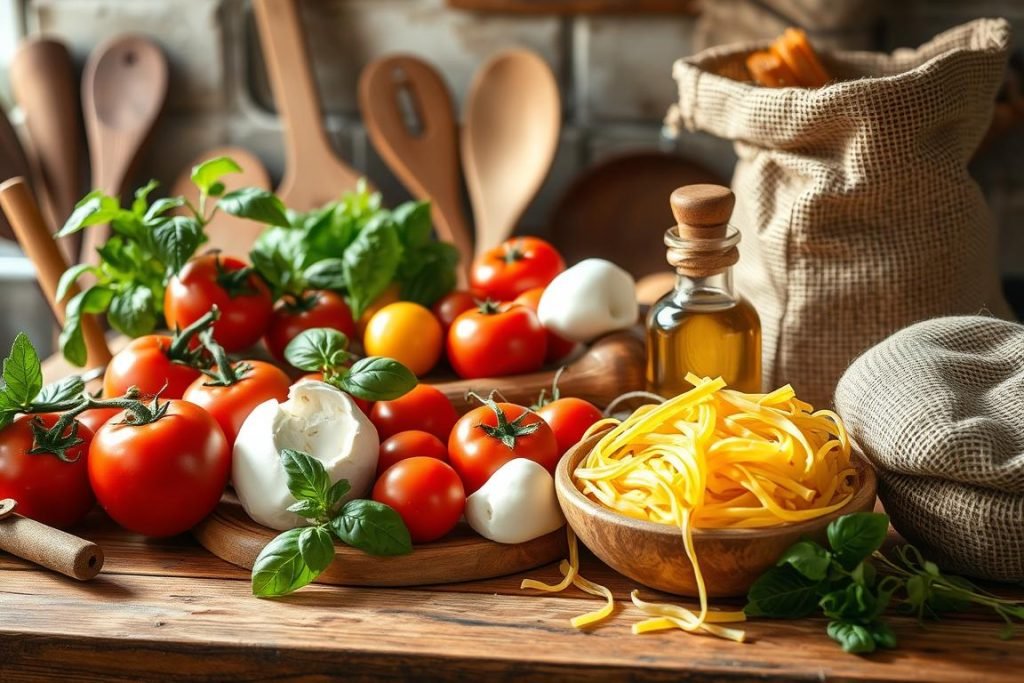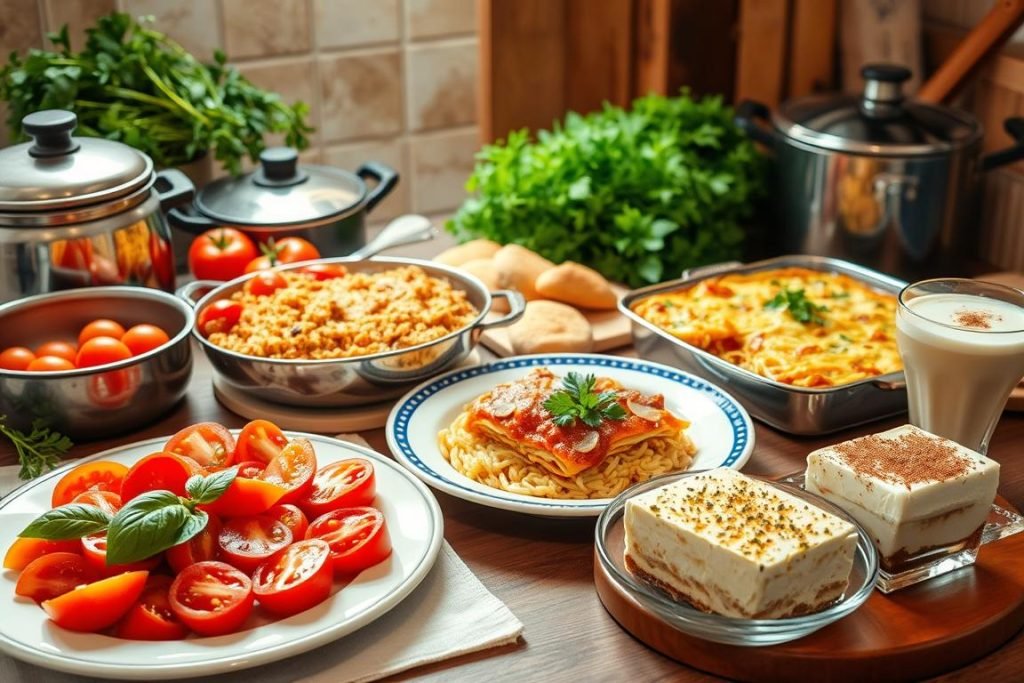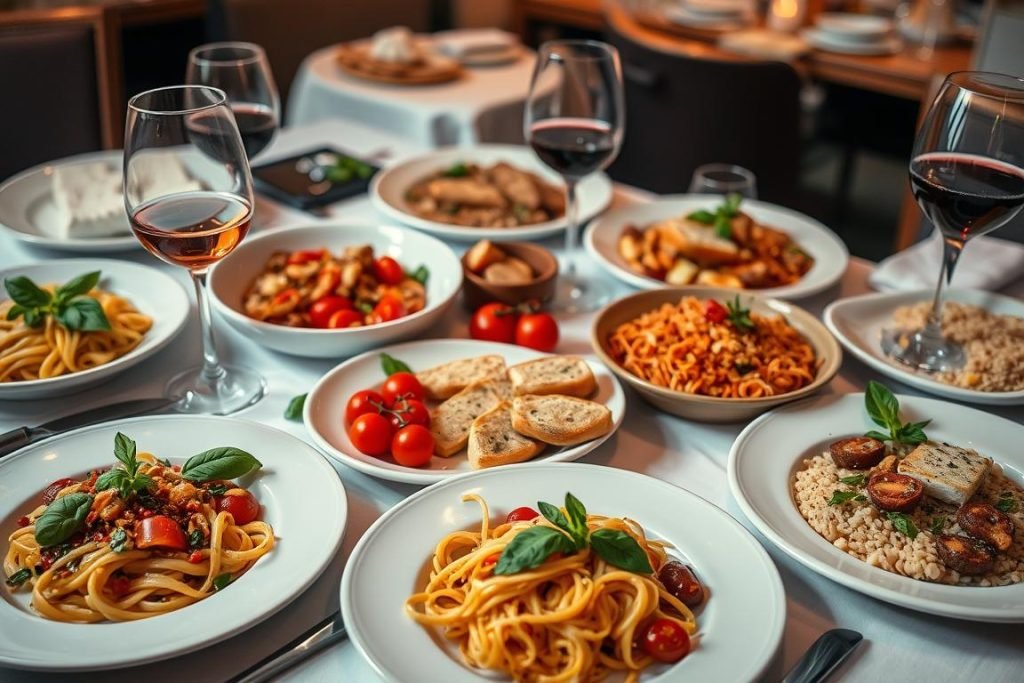Italian Cooking Tips and Tricks | Master Italian Cuisine

Do you dream about mastering Italian cuisine but feel overwhelmed by its simplicity and complexity? Wondering how just a few ingredients can turn your cooking from basic to brilliant? Learn the priceless Italian cooking tips and tricks that will enhance your skills and introduce a genuine Italian flavor to your meals.
Italian cooking emphasizes quality and lets the true flavors stand out. Experts from Serious Eats say mastering Italian cooking means knowing your ingredients and how to cook them. Top Italian chefs believe paying attention to small details can make a big difference. This could mean improving how you cook artichokes or getting back to basics.
To incorporate these ideas into your dishes, think about focusing on the quality and handling of ingredients rather than seeking out rare ones. The tomatoes you choose and how you use herbs can affect the taste and authenticity of your dishes greatly.
Key Takeaways
- Opt for quality over quantity; higher-grade tomatoes are worth the nominal price increase.
- Master the ‘less is more’ philosophy; two well-chosen ingredients can make a dish sing.
- Incorporate fresh herbs like parsley and basil at the end of cooking to preserve their vibrant zest.
- Understand that in Italian cuisine, time and temperature play vital roles; this includes the dough for focaccia needing hours to rise and the oven temperature for perfect pizza.
- Remember that the little things matter, like never rinsing your pasta post-boiling (unless for a salad) and letting your meat rest for improved flavor.
- Appreciate the nuances of pasta, from achieving al dente texture to matching the correct pasta shape with its sauce counterpart.
- Cherish the process of cooking with engagement, as Italian cuisine is a labor of love, especially when kneading dough for the quintessential pizza or pasta.
Decoding the “Grammar” of Italian Cuisine
Learning traditional Italian cuisine is like learning a complex language. Every ingredient and technique is a unique term, making complete, beautiful dishes. This section will teach you about the key parts and cooking methods of Italian culinary ‘grammar.’ We want you to experience Italian cuisine in a creative and confident way.
Fundamentals of Italian Techniques and Ingredients
The secret to mastering Italian cuisine is knowing the essential cooking techniques and ingredients. Italian cooking values freshness and simplicity. It often uses items like olive oil, garlic, and fresh herbs. Techniques like sautéing, emulsifying, and making pasta are important. They’re not just methods. They’re part of a cultural heritage. These techniques keep dishes like risotto and carbonara true to their origins.
Building Your Italian Cooking Vocabulary
Learning different pasta recipes is like expanding your language vocabulary. Each type of pasta, from fusilli to tagliatelle, brings a new experience. It interacts in unique ways with sauces and ingredients. Knowing these variations lets you experiment and improve your cooking. Also, using Italian cooking methods correctly allows you to remake traditional dishes or create your own variations.
Diving into Italian cuisine’s world introduces you to its rich history. By mastering the basics, you’re joining a conversation with cooks who’ve shared their love of Italian cooking. Let this adventure improve your culinary skills and inspire you to add your personal touch to classic dishes. This journey helps you become a chef who replicates and innovates in this amazing culinary tradition.
Embracing Quality Ingredients for Authentic Flavors
Mastering Italian cuisine focuses on the ingredients as much as on cooking techniques. Selecting top-notch Italian ingredients is crucial for the distinct flavors of Italy’s regional dishes. This understanding changes how you cook Italian food, whether at home or professionally.
To fully appreciate Italian ingredients, start by visiting local markets or specialty shops. In dishes like Caprese salad, the taste hinges on the tomatoes’ freshness and the mozzarella’s quality. Serious Eats suggests choosing fresh market produce whenever these ingredients are key.

Every ingredient in traditional Italian cooking plays a vital role in bringing out genuine flavors. Using items like sun-ripened tomatoes, fresh basil, and local olive oils can take your cooking to the next level. It gives it that authentic flavor everyone loves.
| Ingredient | Role in Authentic Italian Cuisine | Example of Use |
|---|---|---|
| Fresh Basil | Essential for its aromatic freshness | Pesto, Caprese Salad |
| Ripe Tomatoes | Base for sauces, adding sweetness and acidity | Marinara Sauce, Bruschetta |
| Extra Virgin Olive Oil | Used for cooking, dressing, and finishing dishes | Draped over grilled vegetables, mixing into pasta |
| Hard Cheeses (Parmigiano, Pecorino) | Adds depth and umami to dishes | Grated over Risotto, used in Carbonara |
Adding regional dishes to your cooking, like Piedmont cheeses or Le Marche seafood, adds depth. It also brings a story to your meal. Understanding the regional background of the food is as important as the ingredients themselves.
Chasing the traditional flavors of Italian cuisine leads to a deeper love for Italy’s food scene. So, think of each ingredient as a piece of Italy’s heritage. It’s not just about taste; it’s about bringing history and authenticity to your table.
The Art of Perfecting Pasta
Exploring Italian culinary traditions means learning to prepare perfect pasta. You must pick the right pot and aim for al dente texture. These steps are key to authentic Italian flavors. Let’s learn how to create a pasta masterpiece with age-old Italian cooking tips and tricks.
Mastering Al Dente: The Backbone of Pasta Dishes
Al dente means ‘to the tooth’ in Italian. It’s pasta cooked firm but not hard. Cooking times, pasta quality, and water amount matter. Italian cooking tips and tricks say to use at least 4 quarts of water per pound of pasta, in a 5-6 quarts pot. This lets pasta cook evenly and prevents sticking.
| Ingredient | Quantity | Purpose |
|---|---|---|
| Water | 4 quarts per pound of pasta | Even and thorough cooking |
| Salt | 1 tablespoon per quart of water | Seasoning pasta from within |
The ideal al dente pasta has a light yellow core inside. It’s delightfully chewy and supports rich sauces well. This balance makes every bite flavorful and structured.
The Secret to Starchy Pasta Water
Starchy pasta water is a secret among Italian chefs. This water becomes a magical elixir for sauces after pasta releases starch into it. It emulsifies and thickens sauces, giving a creamy look to your pasta.
Platforms like Serious Eats show how starchy pasta water transforms dishes. The right amount can change simple aglio e olio into a creamy sauce. Just a few extra stirs with this water can elevate pasta recipes to gourmet levels.

With these tips, you’re set to impress with your pasta dishes. It doesn’t matter if you’re a pro or just love cooking at home. It’s about flavor balance, mastering techniques, and enjoying the process. Bon Appétit!
Italian Cooking Tips and Tricks
Dive into Italian cuisine with essential Italian cooking tips and tricks. These tips bring out the best in your cooking. Italian cuisine is all about simple, high-quality ingredients. For example, just salting pasta water right can make your pasta taste and feel better. This shows how basic cooking techniques can make a big difference.

Every ingredient, from tomatoes to herbs, matters a lot. They can change your cooking from okay to amazing. Like, not putting olive oil in pasta water is classic advice. It lets the sauce stick better, so every bite is tasty.
Enhance your cooking with things like fresh herbs. Try adding garlic, rosemary, or basil to olive oil for a flavorful start to dishes. This keeps your cooking simple but amazing. You’ll not only add to your skills but also capture true Italian flavors for your dinners.
| Pasta Cooking Formula | Kitchen Essentials | Italian Specialty |
|---|---|---|
| 10 grams of salt, 100 grams of pasta, 1,000 milliliters of water | Cheese wrapped in wax paper, stored cold | Ragù with deep browning for flavor |
| No olive oil in boiling pasta | Fresh herbs for infusing oil | Aglio e olio as a base for oil-based pasta dishes |
| Starchy pasta water for sauce adhesion | Use of cheese rinds in soups | Different pasta shapes complimenting specific sauces |
Discover the rich variety in kitchen essentials and regional dishes of Italy. Using cheese rinds can make broths taste deeper. And choosing the right pasta shape can make the sauce even better. Each choice shows the depth of Italy’s food culture. With these tips, you can truly enjoy the delicious, comforting flavors of Italy.
Classical Regional Dishes You Must Try
Start an exciting food journey through Italy with these regional dishes. They capture the heart of Italian cooking traditions. Each one brings local culture and generations of family recipes to your plate.
Exploring Flavors from North to South
The flavors in Italy change greatly from north to south. In the North, you’ll find creamy risotto alla Milanese. It’s famous for its rich taste and a neat story involving a Dutch artist. The South, however, serves lighter dishes like Gelato, infused with local almonds and lemons.
Signature Recipes from Each Italian Region
Every region in Italy offers a special dish unique to the area. For example, Bologna is known for its rich Spaghetti Bolognese, prepared in large batches at places like Indaco. Rome boasts the hearty Carbonara, while Genoa is famous for its green, basil pesto.

The secret to dishes like Campania’s tomato pasta is simple yet top-notch ingredients.
In Venice, the Bacalà alla Vicentina shows how versatile cod can be, mixed with olives and Parmigiano.
Learning about these regional dishes makes Italian cuisine even more fascinating. When trying out family recipes, remember the importance of ingredient balance. This is key in dishes like the Panzanella salad, where taste and texture matter.
Italian Kitchen Essentials: Gadgets to Invest In
Real Italian cooking needs the right tools. With the best gadgets, you can make dishes taste like Italy. Whether it’s baking focaccia or making ragù, the correct tools make cooking better.
Kitchen essentials mean more than having lots of gadgets. It’s about having the right ones. Brands like Le Creuset, Staub, and Marcato stand for quality. They are key for those wanting to master Italian cooking. For example, a Le Creuset Dutch oven is perfect for slow-cooked sauces.

| Gadget | Use | Recommended Brand |
|---|---|---|
| Dutch Oven | Cooking ragù, risotto, or osso buco | Le Creuset |
| Pasta Machine | Simplifying pasta-making process | Marcato Atlas |
| Baking Dish | Making lasagna and Italian desserts | Staub Porcelain |
| Pizza Oven | Achieving high temperatures for perfect pizza crust | Ooni Koda 16 |
| Carbon Steel Pizza Stone | Even heating for pizzas and bread | Dough-Joe |
| Stainless Steel Pan | Tossing pasta and searing | Made In |
| Moka Pot | Brewing Italian coffee | Bialetti (3-cup version) |
A perfect Italian kitchen also has a ravioli cutter for holidays. Plus, a strong spider strainer is essential for pasta fans. These tools make Italian cooking easy and fun. They let you try more dishes and flavors loved worldwide.
High-quality kitchen essentials improve your cooking and help you master Italian cuisine. With these tools, you can dive into Italian cooking tips and tricks. Then, every meal is a celebration of taste and tradition.
Wine Pairings That Elevate Your Italian Meal
Italian cuisine and wine pairings are a must for a full experience. The right wine makes Italian dishes taste even better. This creates a meal that’s more than just eating. It’s an experience. Whether it’s a simple pasta or a grand dinner, the right wine is key.
Italy’s wine history goes back to 4000 BC in Sicily. This history has produced a wide range of wines. With over 500 grape types, Italian wines add depth to meals. They turn traditional dishes into something extraordinary.
Guidelines for Pairing Wines with Italian Cuisine
Match the wine to your dish’s main flavors. Acidic wines like Chianti go well with tomato-based sauces. They cut through the sauce’s richness. For creamy dishes, try a full-bodied white wine like Verdicchio, served at 38–45°F. It complements the meal’s richness.
Seafood dishes love light, crisp wines. Vermentino, at 50–54°F, pairs well with spaghetti alle vongole. It highlights the dish and wine’s light, briny tastes.
The Role of Acidity and Tannins in Matching Wines
Acidity and tannins in wine balance out rich, hearty meals. Hearty meals like Florentine steak go great with robust reds like Barolo, at 64-68°F. These wines match the dish’s strong flavors and textures.
For earthy dishes with mushrooms or truffles, try a Piedmont Barolo. Its earthy notes enhance the meal. And a Chianti Classico, chilled at 55-60°F, is perfect for Tuscan stews. It balances the dish’s rich and savory tastes perfectly.

Matching the wine’s profile to your dish is the secret. This careful pairing leads to a peak dining experience. It’s full of authentic tastes and centuries of Italian wine-making tradition.
Rustic Italian Cooking: Cucina Povera
When you dive into traditional Italian cooking, you find cucina povera. It means ‘the kitchen of the poor’. This cooking style shows how to make delicious dishes with little. It uses simple, local ingredients in a clever way. This embodies a tradition of creativity and history.
In “Cucina Povera: The Italian Way of Transforming Humble Ingredients into Memorable Meals,” Pamela Sheldon Johns offers over 60 recipes. These come from the heart of Tuscan peasant cooking. Here, the focus is on cheap, satisfying meals that don’t waste anything. Favorites include the bread-rich Ribollita, Pollo Arrosto al Vin Santo, and sweet Ciambellone. These dishes capture the soul of cucina povera.
The principle of cucina povera is strong in areas like Tuscany, Puglia, and Campania. Here, pasta and bread fill the belly. Meats are often lesser-known cuts but cooked to perfection. This method is sustainable and saves money. The impact of the Nazi Occupation 80 years ago shows cucina povera as a beacon of endurance and cleverness.
Learning about rustic Italian cooking connects you with Italy’s rich, culinary traditions. It tells a story of people turning simple items into wonderful dishes. The spirit of cucina povera teaches modern cooks about being eco-friendly and honouring what the earth gives us.